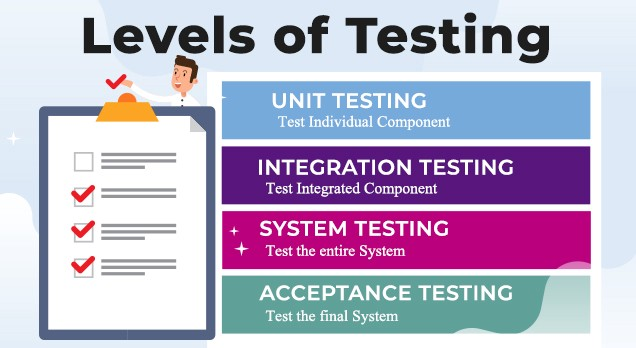What is UAT | User Acceptance Testing?
Of all forms of testing that we execute as part of software quality assurance, user acceptance testing (UAT) is often the most essential to getting it right for the users. The purpose of UAT is to determine if the product is market-ready, in other words, it is able to perform in the hands of real end-users. In terms of naming, it might not be called as such in your organizations; it can also be referred to as alpha or beta testing.
Sometimes, people confuse the differences between user acceptance testing and functional testing. However, this is only confusing when testing phases and techniques are mixed up. In this article, we will focus on UAT.
To begin with, the quality assurance scheme can be divided into the following 4 main levels (phases).

There are four levels of Testing: as development work progresses, it progresses from unit testing, integration testing, and system testing to acceptance testing.
Following these steps, after units (components) have been tested, User Acceptance Testing comes in to verify that a solution in its final form works for the targeted users in the expected environment. It is the last phase of the software testing process that is supposed to confirm whether a product or software is fit for the purpose for which it was built. And we can check by having real end-users test the product in real-world scenarios. Therefore, it is a critical project quality assurance procedure that must occur before the product is rolled out to the market.
It's All About The Users
There is an overlap with other testing techniques, but what makes it different from simply testing functions is that it’s all about the user. Whether the software is constructed in-house or by outsourcing software testing services company, any solutions must go through UAT because users are the ultimate audience who would be paying for your solutions. In product management terminology, UAT is beta testing in which a small group of early adaptors try out the product and provide user feedback. This provides you with important information to know if the solution meets both business requirements and user expectations. After that, once a larger group of users starts to use the solution, market feedback will be provided, which the product team may want to use to determine problem areas that need to be quickly addressed.
Since it puts users’ needs at the center of the discussion, the questions testers need to answer are:
- Q. Are the users able to use the solution without error?
- Q. Does the solution behave in expected ways and meet promised specs?
- Q. Does the solution work when users take a series of unexpected actions?
- Q. Does the solution solve users’ problems after all?
How To Plan and Manage UAT
User acceptance tests can be planned and executed following these steps:
- Determine stakeholders’ and target users’ needs
- UAT scoping, including bug management tool and size of testing
- Design test cases based on product specifications and user journey
- Summarize test runbook and acceptance criteria
- Prepare test data (ex. Registration – 3 days in use – 1 month in use…)
- Set up for beta test users
- Execute the cases
- Keep track of tickets and user feedback
- Regression testing on defects found during UAT
- Confirm the fix and have stakeholders sign off
The key to successful and insightful user acceptance testing is having a clear view of target users’ needs and expected behavior. This understanding equips you to develop defined acceptance criteria and efficient test cases to complete the process quickly, as it’s impossible to test every bit of software that meets every single user’s expectation.
Secondly, as the purpose is to assess the product’s market readiness, it is extremely important to record evidence, track progress with the development team, and report results to stakeholders. Pre-approved test runbooks and acceptance criteria work as the source of truth, and choosing the right bug-tracking tool contributes to smooth communication with the developers who will be fixing the defects found.
Tips on Test Cycle Management
Collecting evidence from end-users and copy-pasting screenshots of test results into an Excel worksheet is very time-consuming. That is why we highly recommend you choose the right tool for your team during the scoping phase to ensure necessary data is collected, visualized, and made sharable to track improvements made after UAT accurately. At SHIFT ASIA, our testers use our own management tool to visualize the data, which speeds up team collaboration.
ContactContact
Stay in touch with Us








